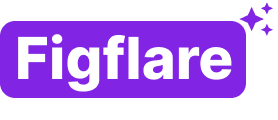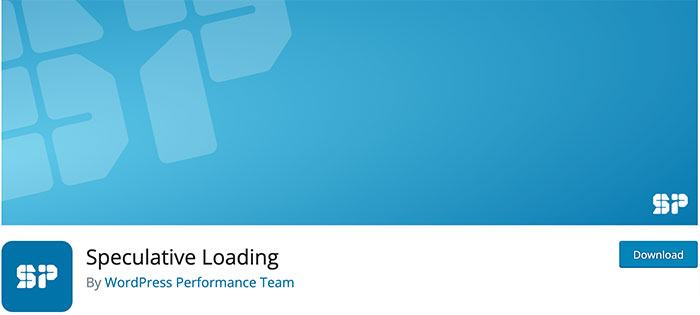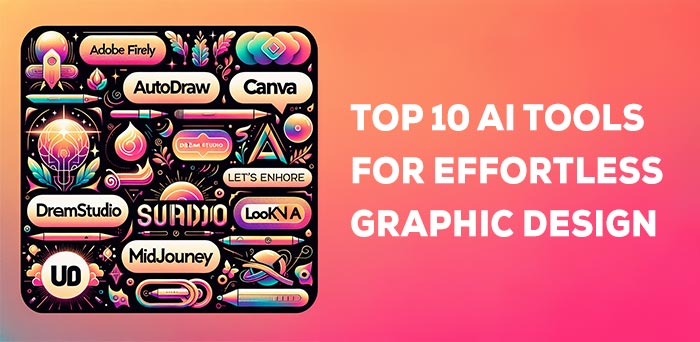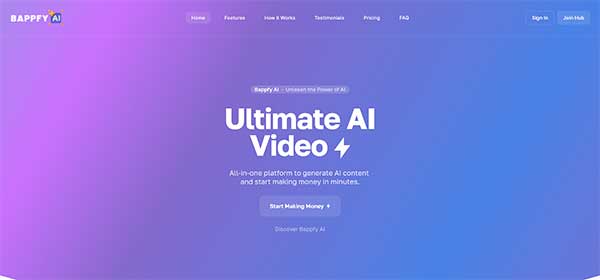The Remarkable Rise of AI in Graphic Design: Unveiling the Top 10 Tools of 2024
In the ever-evolving landscape of graphic design, artificial intelligence (AI) has emerged as a game-changer, ushering in a new era of innovation and efficiency. Over the past year, AI tools have infiltrated various industries, leaving an indelible mark on sectors ranging from entertainment to healthcare. However, one domain that has witnessed an unprecedented surge in AI adoption is the realm of graphic design.
As designers strive to keep pace with the demands of a fast-paced digital world, AI has become an invaluable ally, empowering them to create cutting-edge designs in nearly half the time it would traditionally take. From crafting custom images to generating unique fonts, AI has unleashed a torrent of creative possibilities, providing designers with a powerful toolset to push the boundaries of their craft.
Navigating the vast array of AI graphic design tools available today can be a daunting task. To aid designers in their quest for the perfect AI companion, we’ve curated a comprehensive list of the best tools on the market, along with their capabilities and potential applications.
How AI is Revolutionising Graphic Design
The introduction of AI tools in graphic design has proven to be a transformative force, redefining the way designers approach their work. By harnessing the power of AI, designers can streamline their workflows, stay ahead of the curve, and alleviate the burden of time-consuming tasks, ultimately leading to improved work output and reduced stress levels.
AI tools have found diverse applications throughout the design process. They enable users to upload existing designs and generate numerous iterations or edit them using simple text prompts. These tools can assist in creating intricate design elements such as buttons, text boxes, menus, and icons, saving designers countless hours of meticulous work.
Moreover, AI has proven to be a potent ally in the realm of imagery creation. With the ability to generate various types of visuals, including pictures, photos, and logos, AI tools offer designers an unprecedented level of creative freedom. Whether the desired aesthetic is hyper-realistic or more cartoonish, there is an AI tool capable of bringing those visions to life.
Beyond image generation, AI can also serve as a source of inspiration and a facilitator for design refinement. By rapidly generating thousands of iterations in mere seconds, AI can provide designers with a vast array of ideas to fuel their creative process. This not only accelerates the brainstorming stage but also opens up new avenues for exploration and experimentation.
As the applications of AI in graphic design continue to expand, so too does the array of specialized tools catering to specific design needs. In the following sections, we delve into the top 10 AI graphic design tools that are shaping the industry in 2024.
1. Adobe Firefly
Adobe’s Innovative AI Powerhouse: For designers familiar with the Adobe suite, Firefly is a testament to the company’s commitment to innovation. Initially available as a public beta test phase, Firefly has since evolved into a commercially available standalone tool, making its powerful AI capabilities accessible to a wider audience.
Firefly’s text-to-image generator is a standout feature, allowing users to create stunning visuals simply by inputting detailed prompts. Additionally, Firefly can generate unique text fonts based on user prompts, further expanding the creative possibilities.
One of Firefly’s most compelling features is its ability to recolor SVGs, providing designers with a wide range of color variations for their vector graphics. While Adobe discourages the commercial use of AI-generated images by watermarking them, Firefly remains a valuable tool for exploration and experimentation.
2. Autodraw
Transforming Simple Sketches into Polished Icons: One of the earlier AI tools for graphic design, Autodraw remains a valuable resource for designers seeking to create icons and design elements quickly and efficiently. Autodraw operates on a simple premise: users sketch or draw their desired element, and the AI provides multiple guesses as to what the user is attempting to create.
Users can then select the image or icon that best suits their needs and download it as a PNG file, ready for integration into their creative projects. Autodraw’s versatility makes it an excellent choice for designers of varying skill levels, including those who may not be proficient illustrators or those seeking a quick and accessible way to generate design elements on the fly.
3. Canva
Accessible Design for All Skill Levels: Canva has established itself as one of the most accessible and user-friendly design tools on the market, catering to professionals with a diverse range of skill levels. With its intuitive drag-and-drop design interface, Canva empowers users to create social media posts, posters, brochures, presentations, and a wide array of other design assets with ease.
In addition to its extensive library of free images and pre-made templates, Canva offers an AI-powered tool called Magic Designer. This feature generates custom templates based on text prompts and uploaded images, streamlining the design process even further.
Furthermore, Canva’s Magic Edit tool allows users to edit existing designs by brushing over specific areas and inputting text prompts to replace or modify those elements. This seamless integration of AI into Canva’s design workflow makes it an attractive option for designers seeking an accessible and powerful tool.
4. Designs.ai
The Comprehensive AI Design Suite: Designs.ai stands out as one of the most comprehensive AI graphic design tools available, offering a extensive toolkit that empowers users to create social media posts, logos, videos, and more. Leveraging machine learning algorithms, Designs.ai learns from users’ preferences and design choices, providing personalised and optimised workflows tailored to their specific needs.
With an impressive library of graphics, fonts, design elements, and colors at their disposal, designers have access to a vast array of resources to fuel their creativity. Designs.ai’s machine learning capabilities ensure that the tool continues to evolve and adapt, offering increasingly accurate and relevant design suggestions as users interact with the platform.
For designers who work across various media types or require access to a diverse range of tools, Designs.ai presents an attractive all-in-one solution, consolidating multiple design functions into a single, AI-powered platform.
5. DreamStudio
Energy-Efficient Image Generation: Built by stability.ai, DreamStudio is a text-to-image generator that leverages stable diffusion technology to reduce the energy consumption required to generate stunning visuals. By offering users a diverse array of photo themes and styles, including photorealistic, comic book, gothic, art deco, and more, DreamStudio caters to a wide range of design preferences and aesthetics.
One of DreamStudio’s unique features is the negative prompt capability, which allows users to specify elements they want excluded from the generated image. This level of control and personalisation ensures that designers can create visuals that align precisely with their vision and requirements.
Additionally, DreamStudio enables users to customise various aspects of the image generation process, including the number of images generated, their size, and their level of realism. This flexibility empowers designers to tailor the output to their specific project needs, further enhancing the tool’s versatility.
6. Khroma
Unleashing the Power of Color Palettes: For designers seeking stunning and visually appealing color palettes, Khroma is an AI tool that eliminates the guesswork involved in selecting compatible and engaging color combinations. By leveraging AI, Khroma offers designers an infinite array of color palettes to choose from, taking the tedium out of the color selection process.
Upon initial use, Khroma prompts users to select their favorite colors from a vast selection, allowing the AI to understand their preferences better. Based on these inputs, Khroma generates countless color combinations that users can view in various formats, including text, image, side-by-side, and gradient views.
One of Khroma’s standout features is its ability to allow users to favorite or edit the generated color palettes, further refining the AI’s understanding of their preferences for future iterations. Additionally, designers can upload images and use Khroma to generate complementary color palettes or copy and paste provided hex codes for use in other design platforms.
7. Let’s Enhance
Elevating Image Quality with AI: For designers seeking to enhance the quality of their images, Let’s Enhance is a powerful AI tool that harnesses the capabilities of neural networks. This tool can not only increase the resolution of low-quality photos but also enlarge images of any resolution without compromising detail or quality.
Let’s Enhance’s AI algorithms are capable of filling in missing details that were not originally present in the image, ensuring that even the most pixelated or low-resolution images can be transformed into print-ready or digital media-ready assets.
By leveraging Let’s Enhance’s AI capabilities, designers can confidently prepare images for print or digital media while maintaining the highest possible resolution, ensuring their designs are crisp, clear, and visually stunning.
8. Looka Logo Maker
Crafting Cutting-Edge Logos with Ease: For graphic designers tasked with creating eye-catching logos for multiple companies, Looka Logo Maker is an innovative software that streamlines the logo design process. Featuring an easy-to-use configuration wizard, Looka generates multiple logo options based on user preferences and responses to prompts.
The wizard presents a selection of pre-made logos, allowing users to identify their preferred styles and aesthetics. Users then provide input on preferred colors, symbols, and slogans that best represent the business they are designing for. From there, Looka generates dozens of logo options, which users can further refine using a comprehensive library of layouts, icons, colors, symbols, and fonts.
9. Midjourney
Hyperrealistic Images through Discord: Midjourney has garnered a reputation for generating hyperrealistic images that blur the line between AI-generated and human-made art. Accessible exclusively through a Discord channel, Midjourney offers both free and paid subscription options, catering to users with varying needs and budgets.
While the Discord platform may present a learning curve for some users, Midjourney’s command-based interface is relatively straightforward once mastered. The level of realism achieved by Midjourney’s AI-generated images is truly remarkable, making it challenging to distinguish them from their human-crafted counterparts.
Paid subscriptions provide users with access to un-watermarked images suitable for commercial use, as well as faster processing times, ensuring a smoother and more efficient workflow.
10. Uizard
Effortless Design for Websites, Apps, and Software: Uizard stands out as an intuitive AI tool that simplifies the design process for websites, mobile and web applications, and desktop software. With its vast library of design elements, Uizard allows users to effortlessly drag and drop components onto the workspace, streamlining the creation process.
User-friendly and versatile, Uizard offers the freedom to design from scratch or leverage one of the hundreds of pre-built templates available. Its AI features are a true game-changer, including a text assistant, a text-to-image generator, and the ability to transform uploaded sketches or screenshots into digital mockups.
Two standout features of Uizard are its theme generator, which can generate color palettes and font pairings based on uploaded images or URLs, and its AI-powered design suggestions, which provide users with tailored recommendations based on their preferences and project requirements.
Key Takeaways: Embracing the AI Revolution in Graphic Design
The integration of artificial intelligence tools into the graphic design landscape has ushered in a remarkable era of automation and augmentation, enabling designers to push the boundaries of their creativity while streamlining workflows and increasing efficiency.
From image recognition and generation to advanced color palette curation, the AI tools highlighted in this article exemplify the remarkable strides made in enhancing and accelerating the creative process. As AI technology continues to evolve, we can expect even more innovative and powerful tools to emerge, further transforming the graphic design industry.
Whether you’re a seasoned designer seeking to remain at the forefront of technological advancements or a newcomer to the field eager to harness the power of AI, the tools outlined in this article offer a glimpse into the future of graphic design. By embracing these cutting-edge AI solutions, designers can unlock new realms of creativity, collaborate with intelligent systems, and produce visually stunning designs that captivate audiences and leave a lasting impact.
So, what are you waiting for? Dive into the world of AI-powered graphic design and experience the transformative potential of these revolutionary tools firsthand. Get ready to unleash your creativity like never before – the future of design is here and it’s more empowering than ever.








